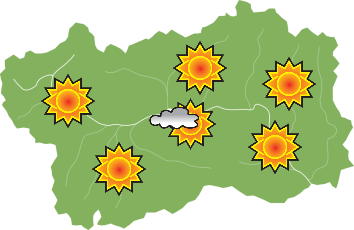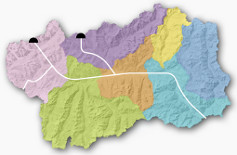The Ayas Valley: the simple and unique flavours from the land of the sabotiers
How: by car.
Recommended duration: two days.
Recommended period: all year round.
Distance: about 34 km.
A journey through the heart of the Ayas Valley, an authentic jewel at the foot of the Monte Rosa, decorated with the historic trails carved out by the merchants coming from Switzerland and Germany, dotted with houses and barns and furrowed by the waters of the Evançon stream.
Cheese
In addition to Fontina DOP cheese, typical to the entire Aosta Valley region, the following dairy products are also well noted in the area:
Valle d’Aosta Fromadzo DOP a cheese made using milk from a breed of cow particular to the Aosta Valley, milked in the pastures of the Upper Ayas Valley, at the foot of the Monte Rosa. Produced using raw milk partially skimmed through natural separation and from at least two milkings, it is a half-fat cheese with a sweet taste when fresh and a stronger salty and spicy taste when more mature. In the summer, the rich flora of the pastures grants the Fromadzo cheese an especially pleasant smell of fresh milk.
Matured toma cheese: cheese made from raw milk in the same way as classic toma cheese, but matured over 60 days and enriched with crushed juniper berries, chilli, chives or mountain herbs.
Interesting facts
From Verrès, bypassing the austere castle that overlooks the village below from the top of a rocky cliff, take the winding road that leads to the Ayas Valley. Stretches of countryside, streams and waterfalls, dark coniferous forests and bright chestnut trees, studded with towers and lonely medieval fortresses lead up to the early settlements: Challand-Saint-Victor and Challand-Saint-Anselme. The cuisine typical of the Aosta Valley, simple and substantial at the same time, can be found in this area with several taste variations, among which is the combination of polenta with the Salignoun cheese, with brossa, a cream made from whey, or flavoursome game stews.
In Champoluc, many restaurants offer a menu called Km zero, made of dishes prepared only with local products: potatoes, aromatic herbs, polenta, cheese and meat from locally bred cattle. In Val d’Ayas the typical cuisine offers the great Aosta Valley classics with special attention to the ancient and simple recipes that never age. In this area, you are most likely to find the frittelle di borragine on your plate, a fritter made from a plant that grows wild in the orchards at the beginning of spring - or the fresse or quagliette, a rich and savoury main course based on cabbage and offal, which is best served with polenta. The rostì are also exquisite: crispy balls of polenta filled with cheese and then fried. All this, not to mention the desserts: the beignets, apple fritters appreciated by both young and old, the stars of traditional evenings in the villages. The menestra de l’ano is an ancient snack, the perfect tonic after a hard day working in the field. It is a peasant soup made from dry rye bread moistened with red wine and flavoured with sugar, cinnamon and cloves.
The typical handicrafts of the Ayas area are the sabots a type of wooden clogs which were once largely made in the area by the sabotier masters; today, the Cooperative Li Tsacolé d’Ayas has been established in order to promote this ancient art. The cooperative’s workshop in Antagnod displays a permanent exhibition of sabots ayassini. Inside the workshop, the sabotiers show the visitors the traditional techniques of making the typical local clogs, demonstrating their quality and peculiarities.












